Wireless Networking and Communication Report: Antenna Comparison
VerifiedAdded on 2020/03/07
|10
|1444
|41
Report
AI Summary
This report provides a comprehensive overview of wireless networking and communication. It begins by examining different types of antennas, including Yagi-uda, horn, and cellular antennas, detailing their strengths, weaknesses, and applications. The report then delves into the comparison and contrast of FDMA and CDMA technologies, highlighting their operational differences and suitability for various communication scenarios. Furthermore, it explores recent advancements in wireless technologies, such as RFID, discussing their advantages and limitations. The report concludes with a forward-looking assessment of the best antenna types for future use, considering factors like long-range communication requirements. The content is well-structured, providing a clear understanding of the subject matter with relevant references.
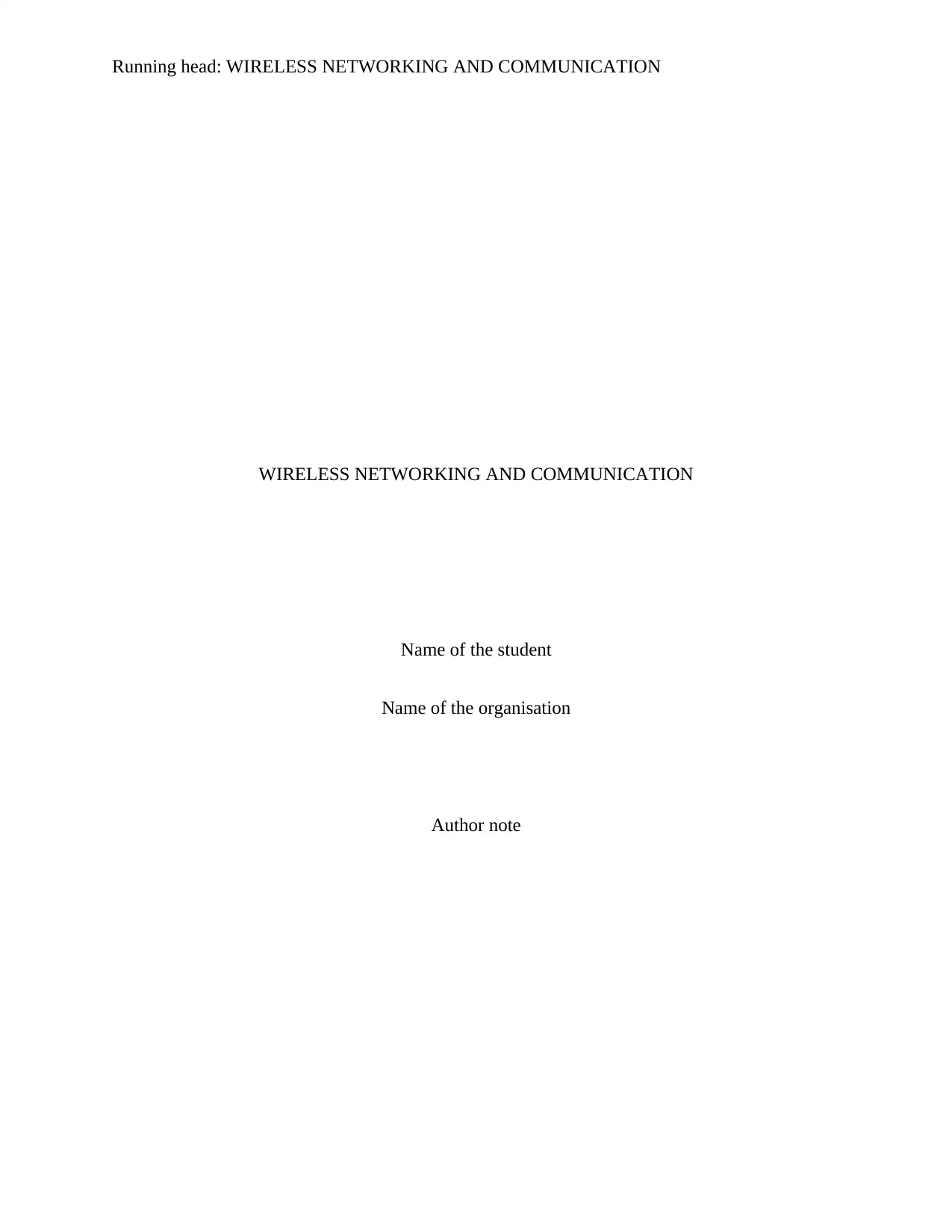
Running head: WIRELESS NETWORKING AND COMMUNICATION
WIRELESS NETWORKING AND COMMUNICATION
Name of the student
Name of the organisation
Author note
WIRELESS NETWORKING AND COMMUNICATION
Name of the student
Name of the organisation
Author note
Paraphrase This Document
Need a fresh take? Get an instant paraphrase of this document with our AI Paraphraser
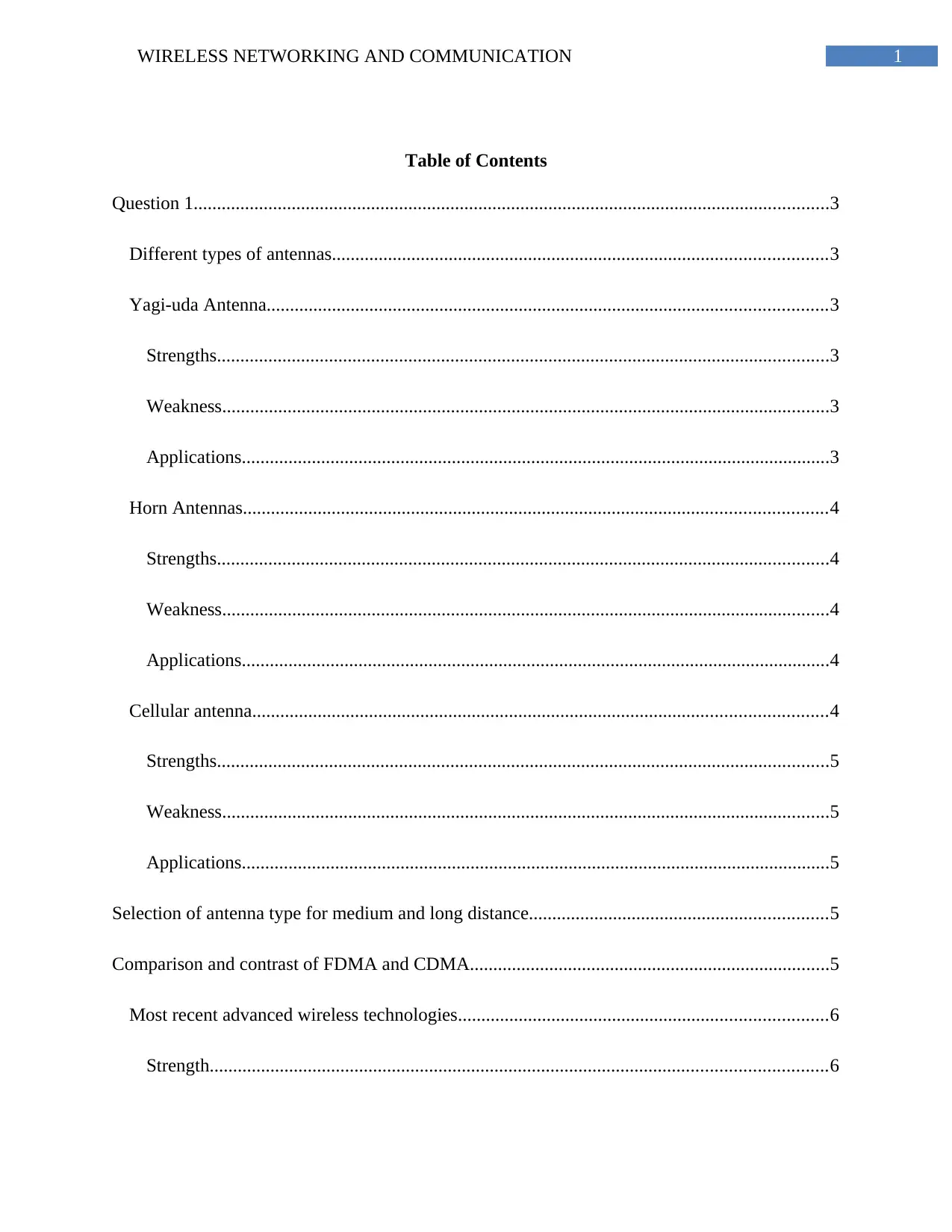
1WIRELESS NETWORKING AND COMMUNICATION
Table of Contents
Question 1........................................................................................................................................3
Different types of antennas..........................................................................................................3
Yagi-uda Antenna........................................................................................................................3
Strengths...................................................................................................................................3
Weakness..................................................................................................................................3
Applications..............................................................................................................................3
Horn Antennas.............................................................................................................................4
Strengths...................................................................................................................................4
Weakness..................................................................................................................................4
Applications..............................................................................................................................4
Cellular antenna...........................................................................................................................4
Strengths...................................................................................................................................5
Weakness..................................................................................................................................5
Applications..............................................................................................................................5
Selection of antenna type for medium and long distance................................................................5
Comparison and contrast of FDMA and CDMA.............................................................................5
Most recent advanced wireless technologies...............................................................................6
Strength....................................................................................................................................6
Table of Contents
Question 1........................................................................................................................................3
Different types of antennas..........................................................................................................3
Yagi-uda Antenna........................................................................................................................3
Strengths...................................................................................................................................3
Weakness..................................................................................................................................3
Applications..............................................................................................................................3
Horn Antennas.............................................................................................................................4
Strengths...................................................................................................................................4
Weakness..................................................................................................................................4
Applications..............................................................................................................................4
Cellular antenna...........................................................................................................................4
Strengths...................................................................................................................................5
Weakness..................................................................................................................................5
Applications..............................................................................................................................5
Selection of antenna type for medium and long distance................................................................5
Comparison and contrast of FDMA and CDMA.............................................................................5
Most recent advanced wireless technologies...............................................................................6
Strength....................................................................................................................................6

2WIRELESS NETWORKING AND COMMUNICATION
Weakness..................................................................................................................................7
Best type of antenna for use in future.......................................................................................7
References........................................................................................................................................8
Weakness..................................................................................................................................7
Best type of antenna for use in future.......................................................................................7
References........................................................................................................................................8
⊘ This is a preview!⊘
Do you want full access?
Subscribe today to unlock all pages.

Trusted by 1+ million students worldwide
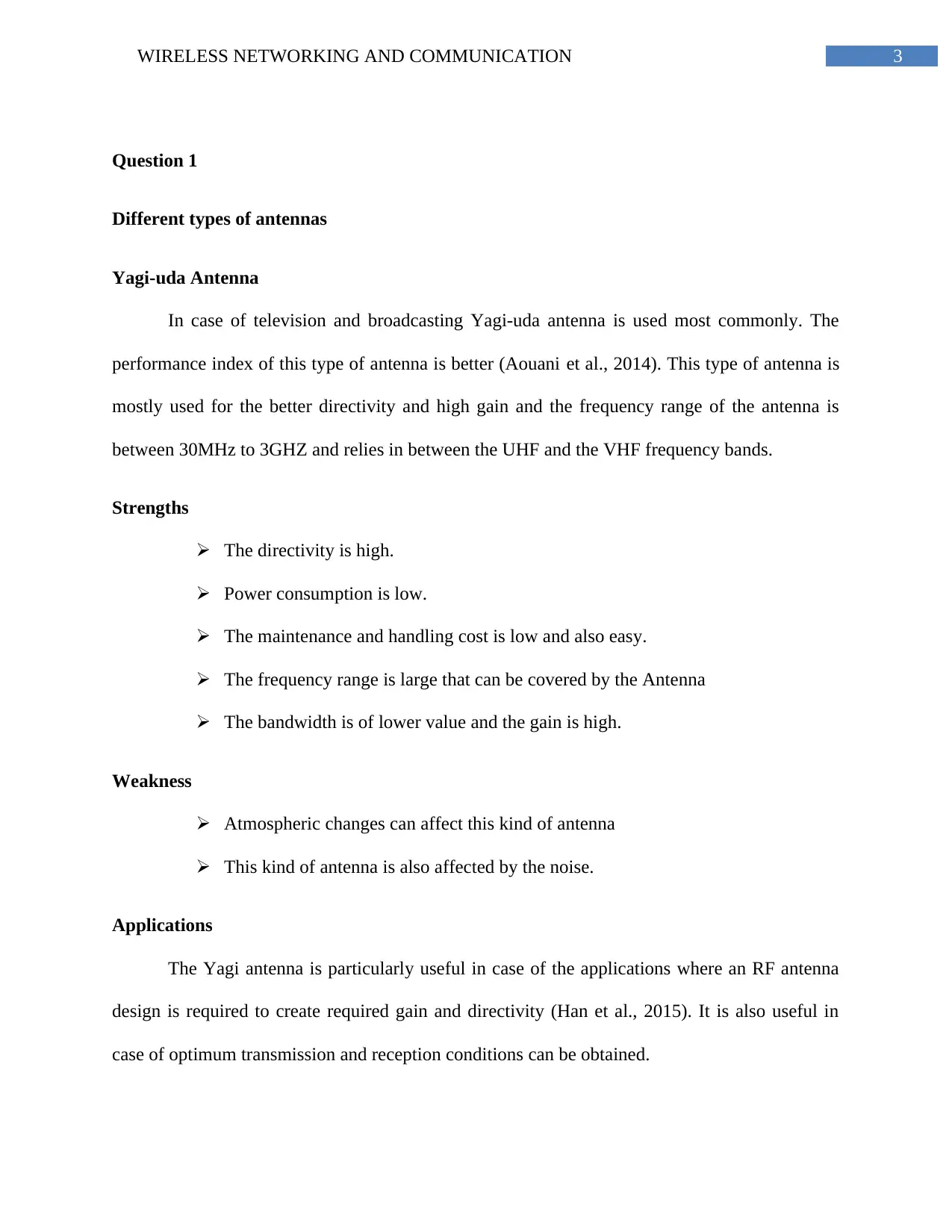
3WIRELESS NETWORKING AND COMMUNICATION
Question 1
Different types of antennas
Yagi-uda Antenna
In case of television and broadcasting Yagi-uda antenna is used most commonly. The
performance index of this type of antenna is better (Aouani et al., 2014). This type of antenna is
mostly used for the better directivity and high gain and the frequency range of the antenna is
between 30MHz to 3GHZ and relies in between the UHF and the VHF frequency bands.
Strengths
The directivity is high.
Power consumption is low.
The maintenance and handling cost is low and also easy.
The frequency range is large that can be covered by the Antenna
The bandwidth is of lower value and the gain is high.
Weakness
Atmospheric changes can affect this kind of antenna
This kind of antenna is also affected by the noise.
Applications
The Yagi antenna is particularly useful in case of the applications where an RF antenna
design is required to create required gain and directivity (Han et al., 2015). It is also useful in
case of optimum transmission and reception conditions can be obtained.
Question 1
Different types of antennas
Yagi-uda Antenna
In case of television and broadcasting Yagi-uda antenna is used most commonly. The
performance index of this type of antenna is better (Aouani et al., 2014). This type of antenna is
mostly used for the better directivity and high gain and the frequency range of the antenna is
between 30MHz to 3GHZ and relies in between the UHF and the VHF frequency bands.
Strengths
The directivity is high.
Power consumption is low.
The maintenance and handling cost is low and also easy.
The frequency range is large that can be covered by the Antenna
The bandwidth is of lower value and the gain is high.
Weakness
Atmospheric changes can affect this kind of antenna
This kind of antenna is also affected by the noise.
Applications
The Yagi antenna is particularly useful in case of the applications where an RF antenna
design is required to create required gain and directivity (Han et al., 2015). It is also useful in
case of optimum transmission and reception conditions can be obtained.
Paraphrase This Document
Need a fresh take? Get an instant paraphrase of this document with our AI Paraphraser
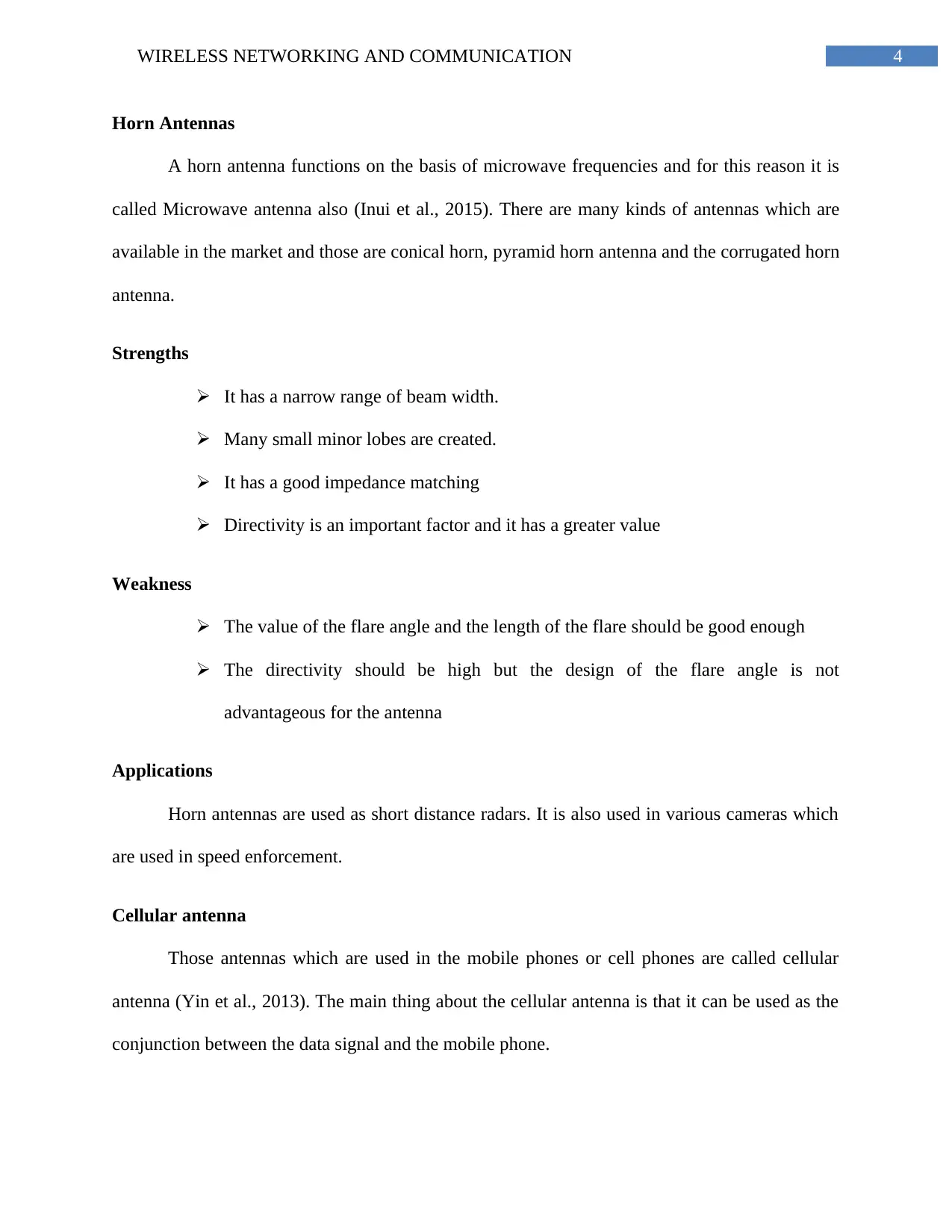
4WIRELESS NETWORKING AND COMMUNICATION
Horn Antennas
A horn antenna functions on the basis of microwave frequencies and for this reason it is
called Microwave antenna also (Inui et al., 2015). There are many kinds of antennas which are
available in the market and those are conical horn, pyramid horn antenna and the corrugated horn
antenna.
Strengths
It has a narrow range of beam width.
Many small minor lobes are created.
It has a good impedance matching
Directivity is an important factor and it has a greater value
Weakness
The value of the flare angle and the length of the flare should be good enough
The directivity should be high but the design of the flare angle is not
advantageous for the antenna
Applications
Horn antennas are used as short distance radars. It is also used in various cameras which
are used in speed enforcement.
Cellular antenna
Those antennas which are used in the mobile phones or cell phones are called cellular
antenna (Yin et al., 2013). The main thing about the cellular antenna is that it can be used as the
conjunction between the data signal and the mobile phone.
Horn Antennas
A horn antenna functions on the basis of microwave frequencies and for this reason it is
called Microwave antenna also (Inui et al., 2015). There are many kinds of antennas which are
available in the market and those are conical horn, pyramid horn antenna and the corrugated horn
antenna.
Strengths
It has a narrow range of beam width.
Many small minor lobes are created.
It has a good impedance matching
Directivity is an important factor and it has a greater value
Weakness
The value of the flare angle and the length of the flare should be good enough
The directivity should be high but the design of the flare angle is not
advantageous for the antenna
Applications
Horn antennas are used as short distance radars. It is also used in various cameras which
are used in speed enforcement.
Cellular antenna
Those antennas which are used in the mobile phones or cell phones are called cellular
antenna (Yin et al., 2013). The main thing about the cellular antenna is that it can be used as the
conjunction between the data signal and the mobile phone.
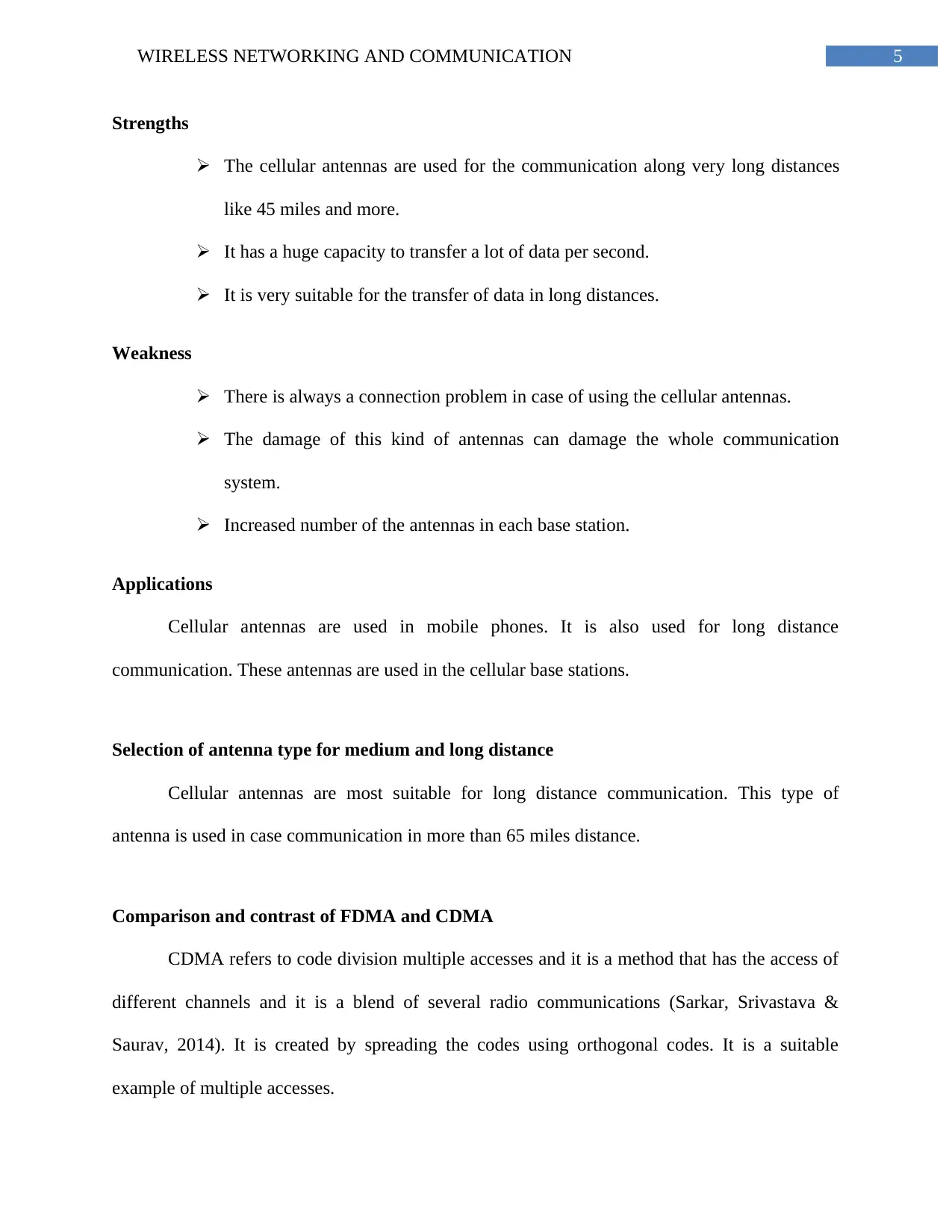
5WIRELESS NETWORKING AND COMMUNICATION
Strengths
The cellular antennas are used for the communication along very long distances
like 45 miles and more.
It has a huge capacity to transfer a lot of data per second.
It is very suitable for the transfer of data in long distances.
Weakness
There is always a connection problem in case of using the cellular antennas.
The damage of this kind of antennas can damage the whole communication
system.
Increased number of the antennas in each base station.
Applications
Cellular antennas are used in mobile phones. It is also used for long distance
communication. These antennas are used in the cellular base stations.
Selection of antenna type for medium and long distance
Cellular antennas are most suitable for long distance communication. This type of
antenna is used in case communication in more than 65 miles distance.
Comparison and contrast of FDMA and CDMA
CDMA refers to code division multiple accesses and it is a method that has the access of
different channels and it is a blend of several radio communications (Sarkar, Srivastava &
Saurav, 2014). It is created by spreading the codes using orthogonal codes. It is a suitable
example of multiple accesses.
Strengths
The cellular antennas are used for the communication along very long distances
like 45 miles and more.
It has a huge capacity to transfer a lot of data per second.
It is very suitable for the transfer of data in long distances.
Weakness
There is always a connection problem in case of using the cellular antennas.
The damage of this kind of antennas can damage the whole communication
system.
Increased number of the antennas in each base station.
Applications
Cellular antennas are used in mobile phones. It is also used for long distance
communication. These antennas are used in the cellular base stations.
Selection of antenna type for medium and long distance
Cellular antennas are most suitable for long distance communication. This type of
antenna is used in case communication in more than 65 miles distance.
Comparison and contrast of FDMA and CDMA
CDMA refers to code division multiple accesses and it is a method that has the access of
different channels and it is a blend of several radio communications (Sarkar, Srivastava &
Saurav, 2014). It is created by spreading the codes using orthogonal codes. It is a suitable
example of multiple accesses.
⊘ This is a preview!⊘
Do you want full access?
Subscribe today to unlock all pages.

Trusted by 1+ million students worldwide
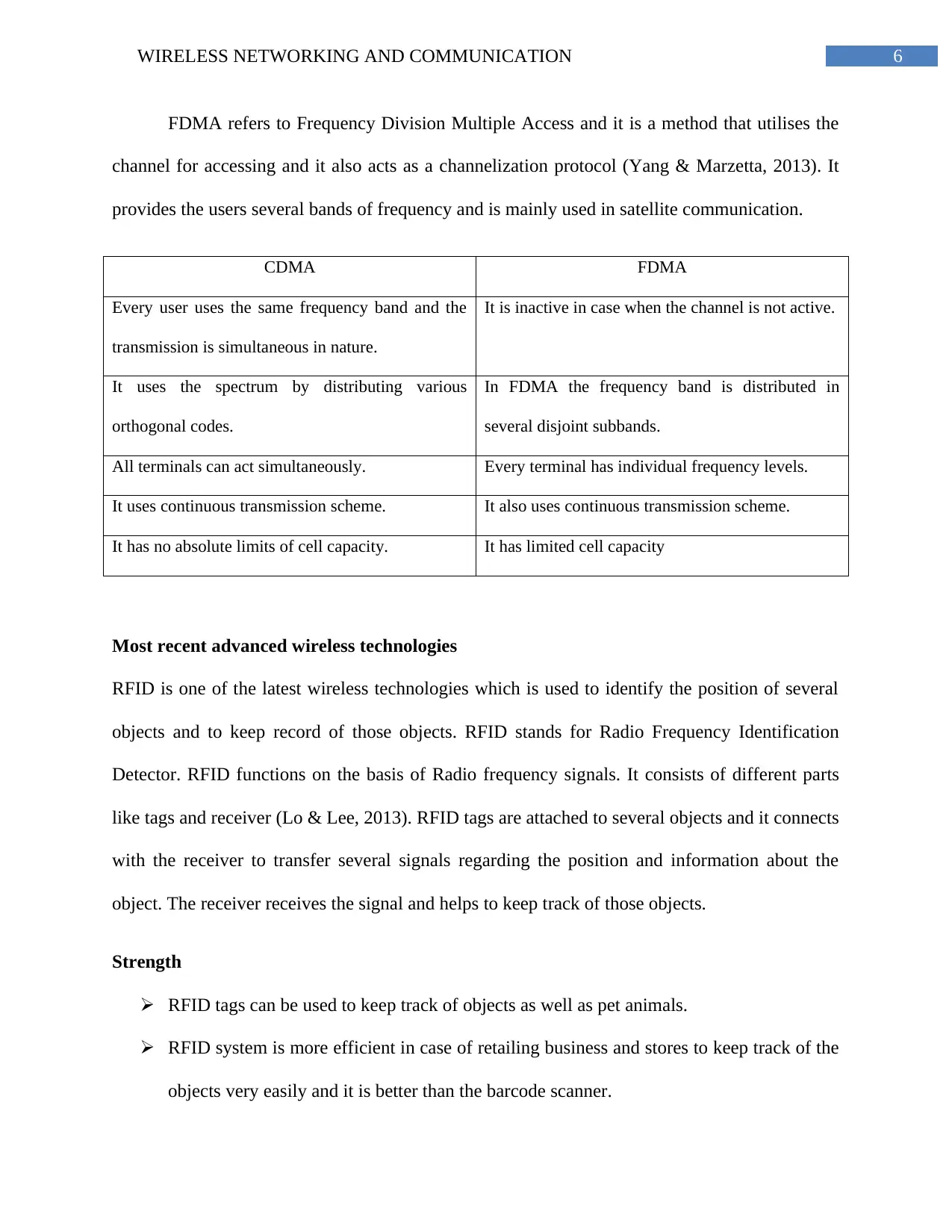
6WIRELESS NETWORKING AND COMMUNICATION
FDMA refers to Frequency Division Multiple Access and it is a method that utilises the
channel for accessing and it also acts as a channelization protocol (Yang & Marzetta, 2013). It
provides the users several bands of frequency and is mainly used in satellite communication.
CDMA FDMA
Every user uses the same frequency band and the
transmission is simultaneous in nature.
It is inactive in case when the channel is not active.
It uses the spectrum by distributing various
orthogonal codes.
In FDMA the frequency band is distributed in
several disjoint subbands.
All terminals can act simultaneously. Every terminal has individual frequency levels.
It uses continuous transmission scheme. It also uses continuous transmission scheme.
It has no absolute limits of cell capacity. It has limited cell capacity
Most recent advanced wireless technologies
RFID is one of the latest wireless technologies which is used to identify the position of several
objects and to keep record of those objects. RFID stands for Radio Frequency Identification
Detector. RFID functions on the basis of Radio frequency signals. It consists of different parts
like tags and receiver (Lo & Lee, 2013). RFID tags are attached to several objects and it connects
with the receiver to transfer several signals regarding the position and information about the
object. The receiver receives the signal and helps to keep track of those objects.
Strength
RFID tags can be used to keep track of objects as well as pet animals.
RFID system is more efficient in case of retailing business and stores to keep track of the
objects very easily and it is better than the barcode scanner.
FDMA refers to Frequency Division Multiple Access and it is a method that utilises the
channel for accessing and it also acts as a channelization protocol (Yang & Marzetta, 2013). It
provides the users several bands of frequency and is mainly used in satellite communication.
CDMA FDMA
Every user uses the same frequency band and the
transmission is simultaneous in nature.
It is inactive in case when the channel is not active.
It uses the spectrum by distributing various
orthogonal codes.
In FDMA the frequency band is distributed in
several disjoint subbands.
All terminals can act simultaneously. Every terminal has individual frequency levels.
It uses continuous transmission scheme. It also uses continuous transmission scheme.
It has no absolute limits of cell capacity. It has limited cell capacity
Most recent advanced wireless technologies
RFID is one of the latest wireless technologies which is used to identify the position of several
objects and to keep record of those objects. RFID stands for Radio Frequency Identification
Detector. RFID functions on the basis of Radio frequency signals. It consists of different parts
like tags and receiver (Lo & Lee, 2013). RFID tags are attached to several objects and it connects
with the receiver to transfer several signals regarding the position and information about the
object. The receiver receives the signal and helps to keep track of those objects.
Strength
RFID tags can be used to keep track of objects as well as pet animals.
RFID system is more efficient in case of retailing business and stores to keep track of the
objects very easily and it is better than the barcode scanner.
Paraphrase This Document
Need a fresh take? Get an instant paraphrase of this document with our AI Paraphraser
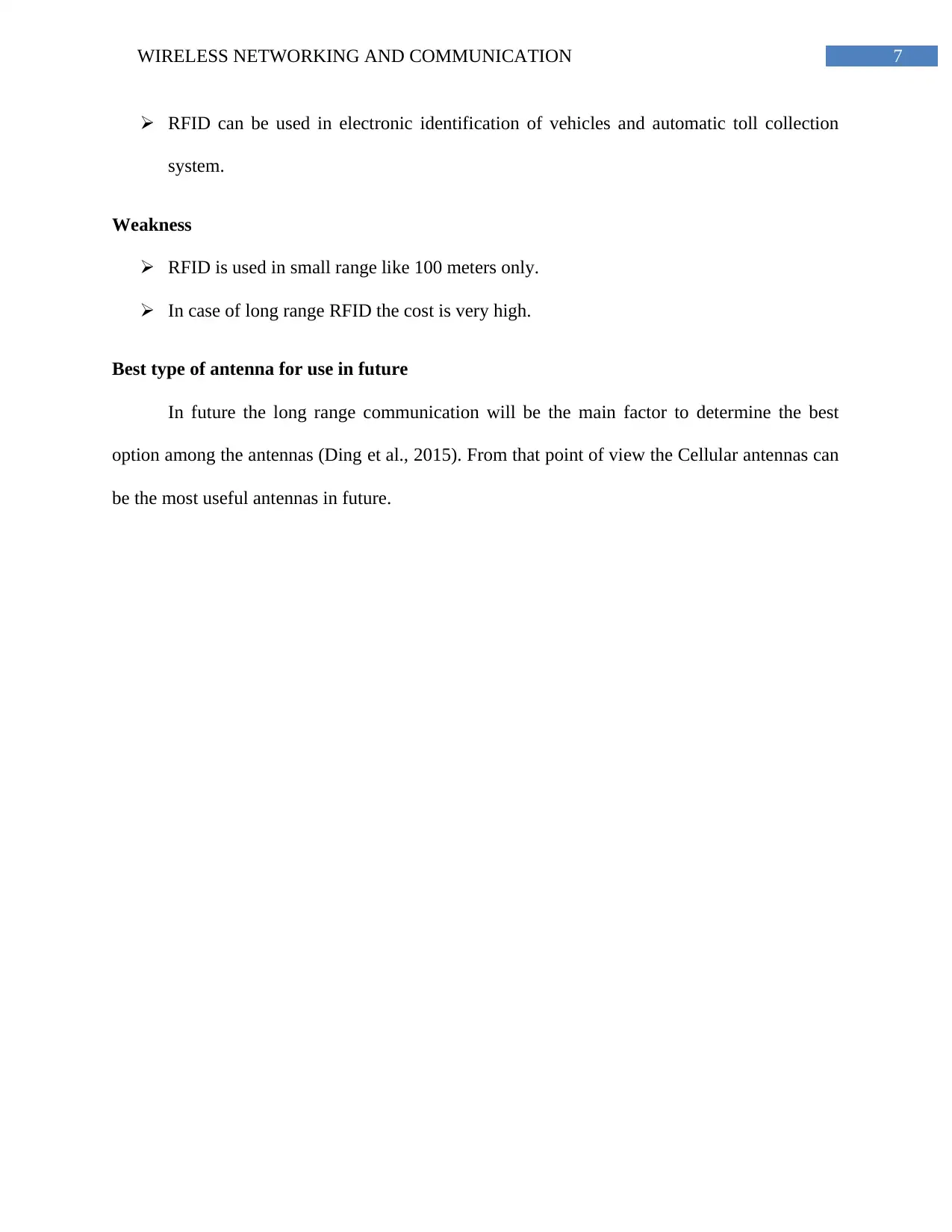
7WIRELESS NETWORKING AND COMMUNICATION
RFID can be used in electronic identification of vehicles and automatic toll collection
system.
Weakness
RFID is used in small range like 100 meters only.
In case of long range RFID the cost is very high.
Best type of antenna for use in future
In future the long range communication will be the main factor to determine the best
option among the antennas (Ding et al., 2015). From that point of view the Cellular antennas can
be the most useful antennas in future.
RFID can be used in electronic identification of vehicles and automatic toll collection
system.
Weakness
RFID is used in small range like 100 meters only.
In case of long range RFID the cost is very high.
Best type of antenna for use in future
In future the long range communication will be the main factor to determine the best
option among the antennas (Ding et al., 2015). From that point of view the Cellular antennas can
be the most useful antennas in future.
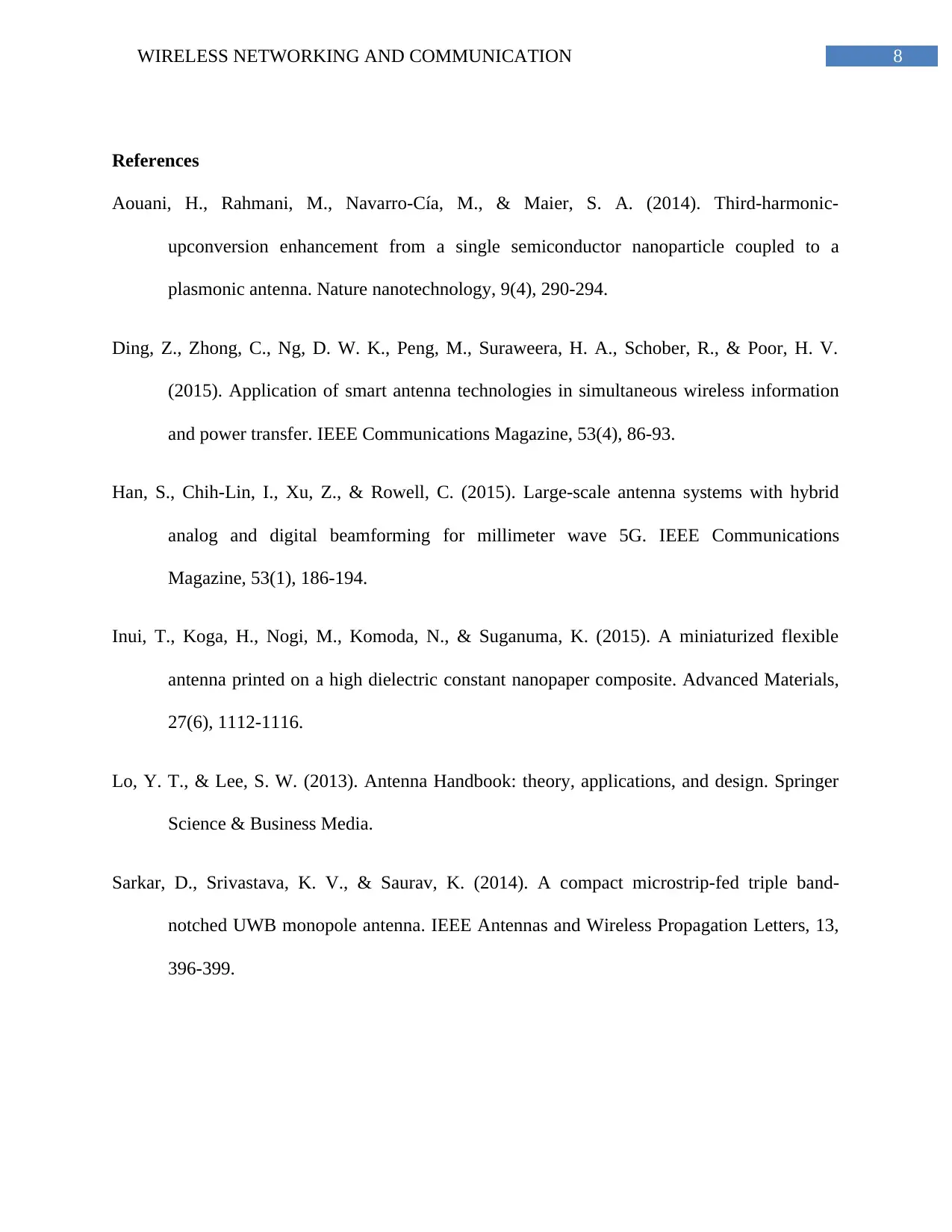
8WIRELESS NETWORKING AND COMMUNICATION
References
Aouani, H., Rahmani, M., Navarro-Cía, M., & Maier, S. A. (2014). Third-harmonic-
upconversion enhancement from a single semiconductor nanoparticle coupled to a
plasmonic antenna. Nature nanotechnology, 9(4), 290-294.
Ding, Z., Zhong, C., Ng, D. W. K., Peng, M., Suraweera, H. A., Schober, R., & Poor, H. V.
(2015). Application of smart antenna technologies in simultaneous wireless information
and power transfer. IEEE Communications Magazine, 53(4), 86-93.
Han, S., Chih-Lin, I., Xu, Z., & Rowell, C. (2015). Large-scale antenna systems with hybrid
analog and digital beamforming for millimeter wave 5G. IEEE Communications
Magazine, 53(1), 186-194.
Inui, T., Koga, H., Nogi, M., Komoda, N., & Suganuma, K. (2015). A miniaturized flexible
antenna printed on a high dielectric constant nanopaper composite. Advanced Materials,
27(6), 1112-1116.
Lo, Y. T., & Lee, S. W. (2013). Antenna Handbook: theory, applications, and design. Springer
Science & Business Media.
Sarkar, D., Srivastava, K. V., & Saurav, K. (2014). A compact microstrip-fed triple band-
notched UWB monopole antenna. IEEE Antennas and Wireless Propagation Letters, 13,
396-399.
References
Aouani, H., Rahmani, M., Navarro-Cía, M., & Maier, S. A. (2014). Third-harmonic-
upconversion enhancement from a single semiconductor nanoparticle coupled to a
plasmonic antenna. Nature nanotechnology, 9(4), 290-294.
Ding, Z., Zhong, C., Ng, D. W. K., Peng, M., Suraweera, H. A., Schober, R., & Poor, H. V.
(2015). Application of smart antenna technologies in simultaneous wireless information
and power transfer. IEEE Communications Magazine, 53(4), 86-93.
Han, S., Chih-Lin, I., Xu, Z., & Rowell, C. (2015). Large-scale antenna systems with hybrid
analog and digital beamforming for millimeter wave 5G. IEEE Communications
Magazine, 53(1), 186-194.
Inui, T., Koga, H., Nogi, M., Komoda, N., & Suganuma, K. (2015). A miniaturized flexible
antenna printed on a high dielectric constant nanopaper composite. Advanced Materials,
27(6), 1112-1116.
Lo, Y. T., & Lee, S. W. (2013). Antenna Handbook: theory, applications, and design. Springer
Science & Business Media.
Sarkar, D., Srivastava, K. V., & Saurav, K. (2014). A compact microstrip-fed triple band-
notched UWB monopole antenna. IEEE Antennas and Wireless Propagation Letters, 13,
396-399.
⊘ This is a preview!⊘
Do you want full access?
Subscribe today to unlock all pages.

Trusted by 1+ million students worldwide
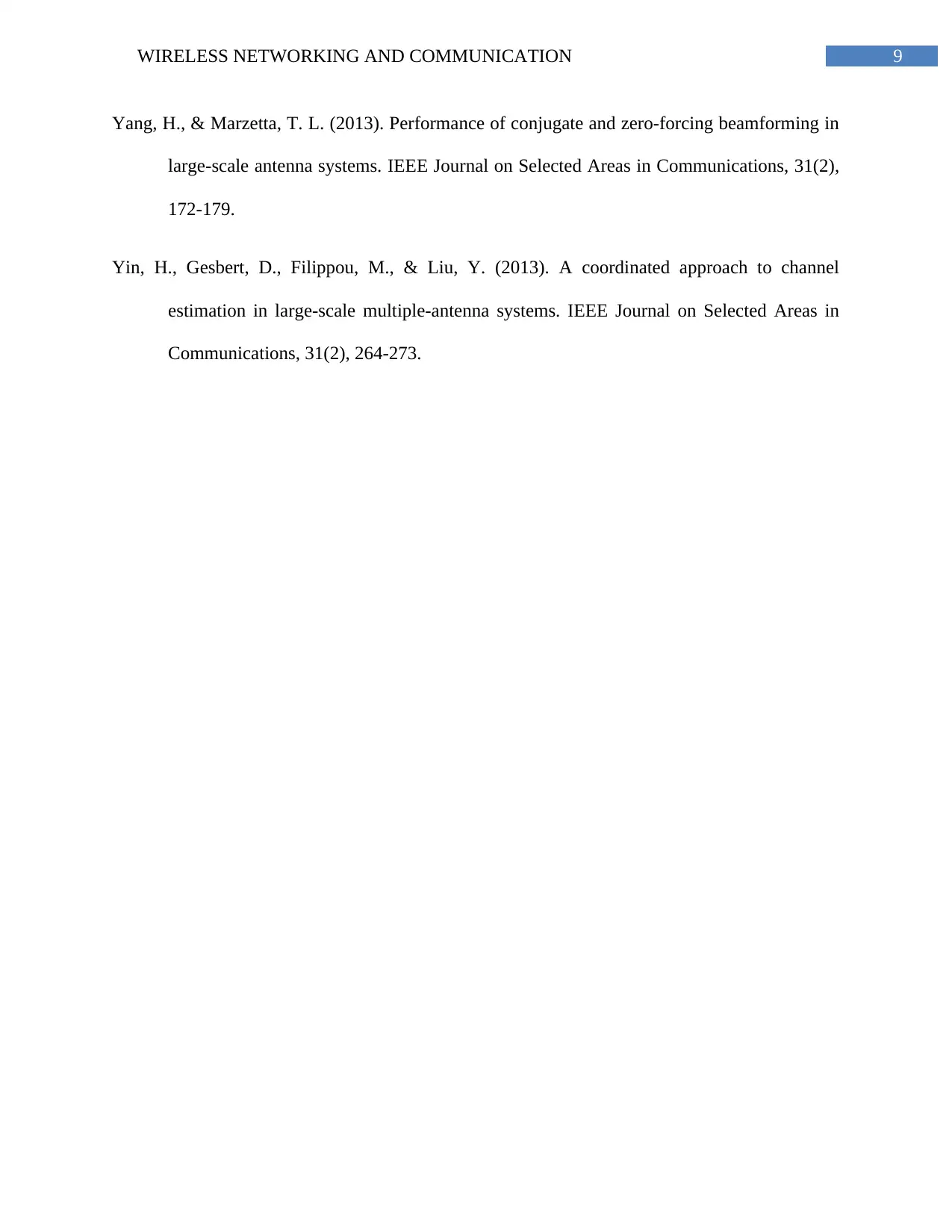
9WIRELESS NETWORKING AND COMMUNICATION
Yang, H., & Marzetta, T. L. (2013). Performance of conjugate and zero-forcing beamforming in
large-scale antenna systems. IEEE Journal on Selected Areas in Communications, 31(2),
172-179.
Yin, H., Gesbert, D., Filippou, M., & Liu, Y. (2013). A coordinated approach to channel
estimation in large-scale multiple-antenna systems. IEEE Journal on Selected Areas in
Communications, 31(2), 264-273.
Yang, H., & Marzetta, T. L. (2013). Performance of conjugate and zero-forcing beamforming in
large-scale antenna systems. IEEE Journal on Selected Areas in Communications, 31(2),
172-179.
Yin, H., Gesbert, D., Filippou, M., & Liu, Y. (2013). A coordinated approach to channel
estimation in large-scale multiple-antenna systems. IEEE Journal on Selected Areas in
Communications, 31(2), 264-273.
1 out of 10
Related Documents
Your All-in-One AI-Powered Toolkit for Academic Success.
+13062052269
info@desklib.com
Available 24*7 on WhatsApp / Email
![[object Object]](/_next/static/media/star-bottom.7253800d.svg)
Unlock your academic potential
Copyright © 2020–2025 A2Z Services. All Rights Reserved. Developed and managed by ZUCOL.




